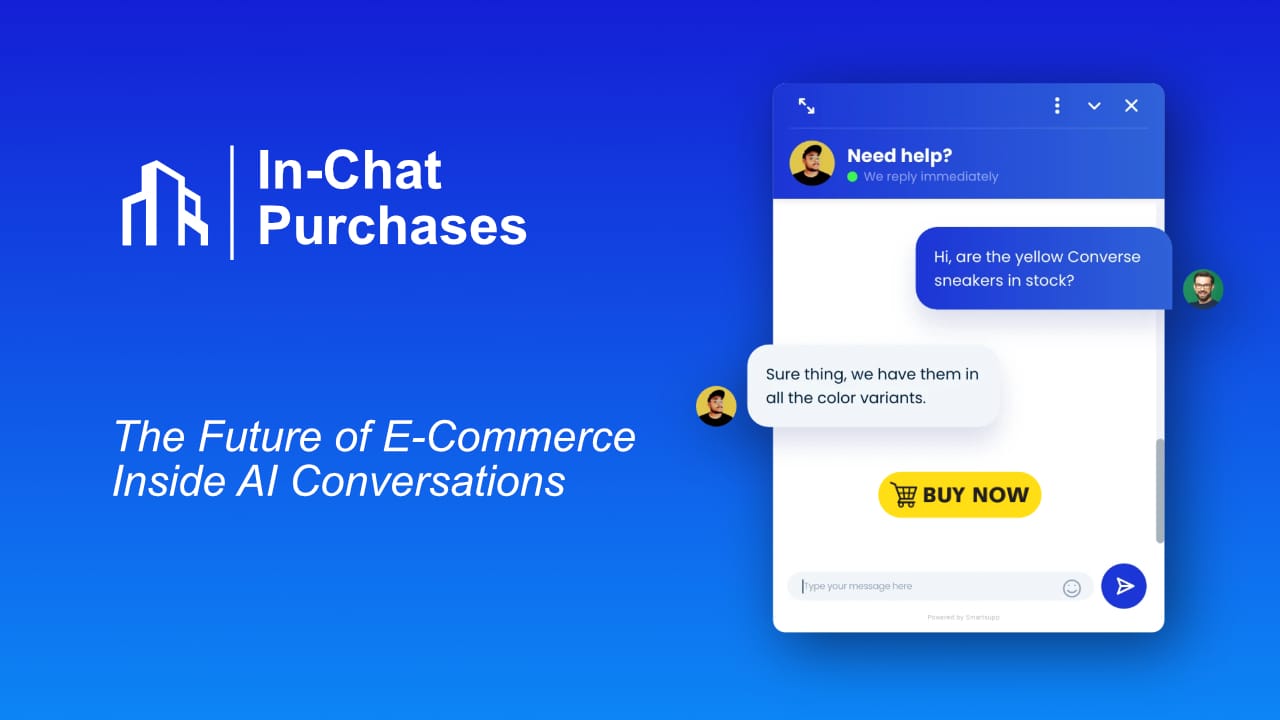In-Chat Purchases: The Future of E-Commerce Inside AI Conversations
In-Chat Purchases are redefining e-commerce by moving product discovery, decision and checkout inside AI conversations. Shopify, OpenAI and Perplexity are already building the first wave of chat-native commerce.

For the past decade, e-commerce has depended on the same basic flow. A user searches, lands on a product page, adds an item to a cart, goes through checkout, enters payment details and completes the order. Every step in that sequence is friction, and every friction point loses sales.
In-Chat Purchases erase that flow entirely. The product is discovered, evaluated, and ordered inside the chat itself. There is no browser, no storefront, no cart, no redirect. The chat agent becomes the storefront, the filter, the comparison engine and the checkout all at once.
What Makes In-Chat Purchases Different
Traditional e-commerce is built around pages and sessions. In-Chat Purchases are built around intent and response. Instead of a visitor journey that takes 12–20 clicks, the full purchase process can be reduced to a single interaction.
User: Recommend a noise cancelling headset under 250 euros
AI: Here are three options, all in stock and eligible for free delivery
User: Order the second one
AI: Purchase confirmed
That is the entire funnel.
The key shift is not convenience. It is control. Once the transaction happens inside the chat platform, the merchant no longer owns the environment around the sale. That power shifts to the AI layer.
Shopify and OpenAI: The First Major Rollout
Shopify and OpenAI are preparing the first full-scale implementation of native In-Chat Purchases. The model is simple:
- Shopify provides product feeds, inventory, pricing, checkout endpoints
- OpenAI provides the chat agent, product ranking and purchase flow
- The user never leaves the chat
- The order is processed by Shopify, not OpenAI
- OpenAI earns a transaction fee for facilitating the sale
This will be the first time a mainstream AI model becomes a real transactional surface, not just a recommendation layer. As soon as one platform proves this increases conversion, the rest of the industry will replicate it.
Perplexity: Already Live
Perplexity is not exploring this idea. They are already executing it.
Their “Shop with Pro” feature allows direct checkout inside their interface. Payment flows are available through PayPal and Venmo. The merchant stays merchant-of-record, but the user never visits the merchant’s site. Discovery, decision and transaction all happen inside Perplexity’s interface.
This makes Perplexity the current frontrunner in practical, working In-Chat Purchases.
Claude, Copilot, Meta AI: Close Behind
Claude
Claude does not yet support native checkout, but its structured output model and API-first ecosystem make it almost commerce-ready. Its positioning suggests it will integrate with third-party ordering and inventory systems before long.
Microsoft Copilot
Copilot already integrates with enterprise workflows and Microsoft payments infrastructure. Adding commerce triggers is a logical next step, especially for B2B procurement and SaaS purchasing.
Meta AI
Meta owns Messenger, WhatsApp and Instagram — three of the biggest untapped conversational commerce surfaces in the world. Once Meta decides to merge its chatbot layer with payments, they can roll out In-Chat Purchases to billions of users overnight.
The race is not who can build it. The race is who deploys it at scale first.
What This Means for Merchants and Brands
In-Chat Purchases change the rules completely. The storefront is no longer the optimisation surface. The data layer is.
Instead of asking:
How do I improve my product page?
You will be asking:
How do I make my product machine-readable so the agent can recommend it?
Instead of optimising for conversion rate on your site, you will optimise for how well the agent understands:
- Stock
- Pricing
- Delivery speed
- Reviews
- Variants
- Return policy
- Product attributes
The future version of e-commerce SEO is “agent ranking.” Whoever the AI recommends first, sells first.
A New Competitive Landscape
Three things will matter more than anything else:
- Structured product data that an AI agent can trust
- Real-time inventory and fulfilment signals
- Platform-agnostic commerce APIs
The brands that lose are the ones still focused on “website experience” when buyers are no longer visiting websites.
The brands that win are the ones whose products are easiest for AI agents to evaluate and transact.
What Happens Next
2025: Shopify-OpenAI pilot goes public
2026: Perplexity expands beyond US, Meta joins the race
2027: In-Chat Purchases take 10 to 20 percent of online retail transactions
2028: First large merchants shut down the website checkout entirely and move to agent-commerce only
The e-commerce shift is no longer about storefront design. It is about who controls the point of decision. And soon, the point of decision will live inside the chat.
Want to explore what this shift means for your business?
Schedule a conversation through the agenda below and let’s map out how In-Chat Purchases could fit into your roadmap.
